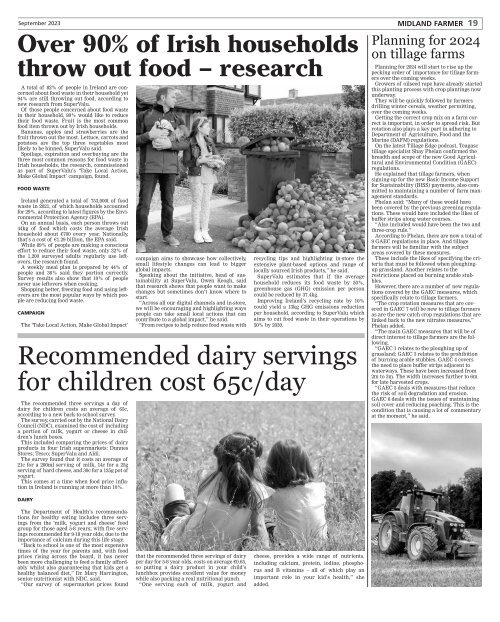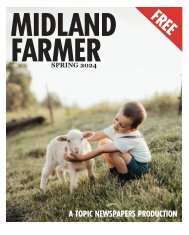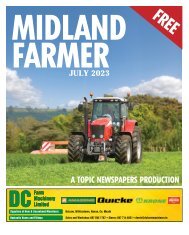You also want an ePaper? Increase the reach of your titles
YUMPU automatically turns print PDFs into web optimized ePapers that Google loves.
<strong>September</strong> <strong>2023</strong><br />
Over 90% of Irish households<br />
throw out food – research<br />
A total of 82% of people in Ireland are concerned<br />
about food waste in their household yet<br />
94% are still throwing out food, according to<br />
new research from SuperValu.<br />
Of those people concerned about food waste<br />
in their household, 80% would like to reduce<br />
their food waste. Fruit is the most common<br />
food item thrown out by Irish households.<br />
Bananas, apples and strawberries are the<br />
fruit thrown out the most. Lettuce, carrots and<br />
potatoes are the top three vegetables most<br />
likely to be binned, SuperValu said.<br />
Spoilage, expiration and overbuying are the<br />
three most common reasons for food waste in<br />
Irish households, the research, commissioned<br />
as part of SuperValu’s ‘Take Local Action,<br />
Make Global Impact’ campaign, found.<br />
FOOD WASTE<br />
Ireland generated a total of 753,000t of food<br />
waste in 2021, of which households accounted<br />
for 29%, according to latest figures by the Environmental<br />
Protection Agency (EPA).<br />
On an annual basis, each person throws out<br />
44kg of food which costs the average Irish<br />
household about €700 every year. Nationally,<br />
that’s a cost of €1.29 billion, the EPA said.<br />
While 89% of people are making a conscious<br />
effort to reduce their food waste, only 32% of<br />
the 1,200 surveyed adults regularly use leftovers,<br />
the research found.<br />
A weekly meal plan is prepared by 44% of<br />
people and 36% said they portion correctly.<br />
Survey results also show that 10% of people<br />
never use leftovers when cooking.<br />
Shopping better, freezing food and using leftovers<br />
are the most popular ways by which people<br />
are reducing food waste.<br />
CAMPAIGN<br />
The ‘Take Local Action, Make Global Impact’<br />
campaign aims to showcase how collectively,<br />
small lifestyle changes can lead to bigger<br />
global impacts.<br />
Speaking about the initiative, head of sustainability<br />
at SuperValu, Owen Keogh, said<br />
that research shows that people want to make<br />
changes but sometimes don’t know where to<br />
start.<br />
“Across all our digital channels and in-store,<br />
we will be encouraging and highlighting ways<br />
people can take small local actions that can<br />
contribute to a global impact,” he said.<br />
“From recipes to help reduce food waste with<br />
recycling tips and highlighting in-store the<br />
extensive plant-based options and range of<br />
locally sourced Irish products,” he said.<br />
SuperValu estimates that if the average<br />
household reduces its food waste by 50%,<br />
greenhouse gas (GHG) emission per person<br />
could be reduced by 37.4kg.<br />
Improving Ireland’s recycling rate by 10%<br />
could yield a 13kg GHG emissions reduction<br />
per household, according to SuperValu which<br />
aims to cut food waste in their operations by<br />
50% by 2030.<br />
Recommended dairy servings<br />
for children cost 65c/day<br />
The recommended three servings a day of<br />
dairy for children costs an average of 65c,<br />
according to a new back-to-school survey.<br />
The survey, carried out by the National Dairy<br />
Council (NDC), examined the cost of including<br />
a portion of milk, yogurt or cheese in children’s<br />
lunch boxes.<br />
This included comparing the prices of dairy<br />
products in four Irish supermarkets: Dunnes<br />
Stores; Tesco; SuperValu and Aldi.<br />
The survey found that it costs an average of<br />
21c for a 200ml serving of milk, 14c for a 25g<br />
serving of hard cheese, and 30c for a 125g pot of<br />
yogurt.<br />
This comes at a time when food price inflation<br />
in Ireland is running at more than 10%.<br />
MIDLAND FARMER<br />
19<br />
Planning for 2024<br />
on tillage farms<br />
Planning for 2024 will start to rise up the<br />
pecking order of importance for tillage farmers<br />
over the coming weeks.<br />
Growers of oilseed rape have already started<br />
this planting process with crop plantings now<br />
underway.<br />
They will be quickly followed by farmers<br />
drilling winter cereals, weather permitting,<br />
over the coming weeks.<br />
Getting the correct crop mix on a farm correct<br />
is important, in order to spread risk. But<br />
rotation also plays a key part in adhering to<br />
Department of Agriculture, Food and the<br />
Marine (DAFM) regulations.<br />
On the latest Tillage Edge podcast, Teagasc<br />
tillage specialist Shay Phelan confirmed the<br />
breadth and scope of the new Good Agricultural<br />
and Environmental Condition (GAEC)<br />
regulations.<br />
He explained that tillage farmers, when<br />
signing-up for the new Basic Income Support<br />
for Sustainability (BISS) payments, also committed<br />
to maintaining a number of farm management<br />
standards.<br />
Phelan said: “Many of these would have<br />
been covered by the previous greening regulations.<br />
These would have included the likes of<br />
buffer strips along water courses.<br />
“Also included would have been the two and<br />
three-crop rule.”<br />
According to Phelan, there are now a total of<br />
9 GAEC regulations in place. And tillage<br />
farmers will be familiar with the subject<br />
areas covered by these measures.<br />
These include the likes of specifying the criteria<br />
that must be followed when ploughingup<br />
grassland. Another relates to the<br />
restrictions placed on burning arable stubbles.<br />
However, there are a number of new regulations<br />
covered by the GAEC measures, which<br />
specifically relate to tillage farmers.<br />
“The crop rotation measures that are covered<br />
in GAEC 7 will be new to tillage farmers<br />
as are the new catch crop regulations that are<br />
linked back to the new nitrates measures,”<br />
Phelan added.<br />
“The main GAEC measures that will be of<br />
direct interest to tillage farmers are the following.<br />
“GAEC 1 relates to the ploughing up of<br />
grassland; GAEC 3 relates to the prohibition<br />
of burning arable stubbles. GAEC 4 covers<br />
the need to place buffer strips adjacent to<br />
waterways. These have been increased from<br />
2m to 3m. The width increases further to 6m<br />
for late harvested crops.<br />
“GAEC 5 deals with measures that reduce<br />
the risk of soil degradation and erosion.<br />
GAEC 6 deals with the issues of maintaining<br />
soil cover and reducing poaching. This is the<br />
condition that is causing a lot of commentary<br />
at the moment,” he said.<br />
DAIRY<br />
The Department of Health’s recommendations<br />
for healthy eating includes three servings<br />
from the ‘milk, yogurt and cheese’ food<br />
group for those aged 5-8 years; with five servings<br />
recommended for 9-18 year olds, due to the<br />
importance of calcium during this life stage.<br />
“Back to school is one of the most expensive<br />
times of the year for parents and, with food<br />
prices rising across the board, it has never<br />
been more challenging to feed a family affordably<br />
whilst also guaranteeing that kids get a<br />
healthy balanced diet,” Dr. Mary Harrington,<br />
senior nutritionist with NDC, said.<br />
“Our survey of supermarket prices found<br />
that the recommended three servings of dairy<br />
per day for 5-8 year olds, costs on average €0.65,<br />
so putting a dairy product in your child’s<br />
lunchbox provides excellent value for money<br />
while also packing a real nutritional punch.<br />
“One serving each of milk, yogurt and<br />
cheese, provides a wide range of nutrients,<br />
including calcium, protein, iodine, phosphorus<br />
and B vitamins – all of which play an<br />
important role in your kid’s health,” she<br />
added.
















